It has been a while since we’ve had some fashion illustrations, and recently I examined a number of beautifully illustrated menswear ads from 1935 which I would like to present today. Clearly at the time, the general level and formality of clothing style was considerably higher, especially in the U.S, and a properly dressed man would rarely leave the house without a hat on his head.
Thirties Hats
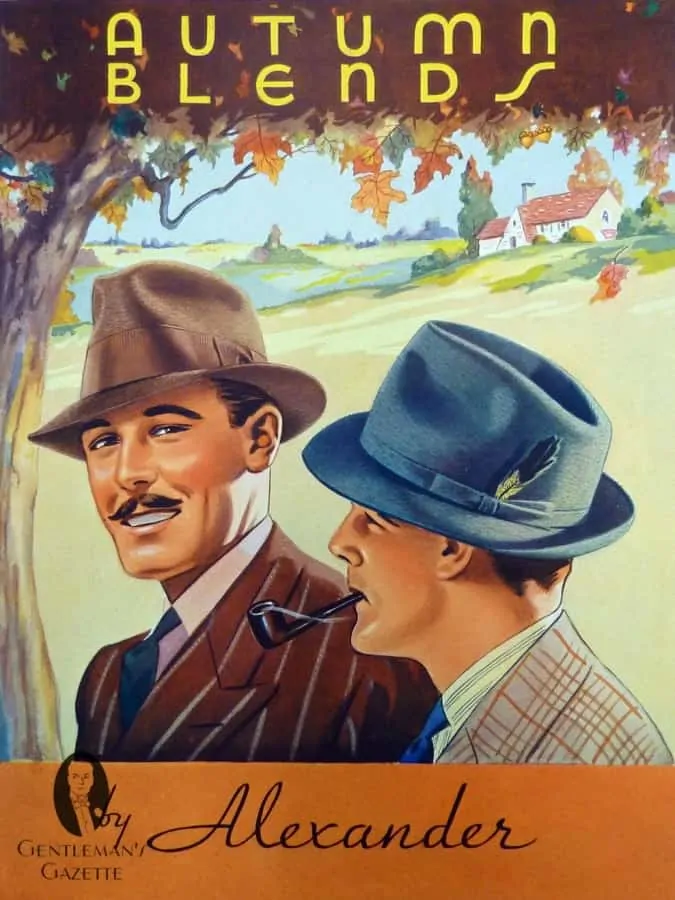
Due to much higher demand for hats, American men had endless choices when it came to hats. On the left, you can see a gentleman with a dapper looking hat in brown. The illustrators cleverly imitated the texture of beaver felt. The band is made of a bold grosgrain ribbon wider than most bands you will find today. He wears a yellow scarf and pairs them with yellow gloves and a boutonniere. (Make sure to enlarge all the pictures so you see the full details).
On the right, you see to gentlemen in fall/winter outfits. On the left hand side, you can see a bold chalk stripe suit in a darker shade of brown than his hat. He combines it with a lavender shirt and white contrast collar as well as a solid dark blue tie. The felt is polished to a beautiful sheen, which is something you won’t get from a wool felt hat. This picture is a great example of how well pale purple or lavender, brown and navy blue can work together. It is not a color combination you see very often today, so next time you are deciding on your outfit, keep purple, navy and brown in mind.
The second gentleman wears a plaid sportcoat in brown-grey and combines it with a pale yellow and blue striped shirt and gray-blue hat with a feather and a pipe. Because of this more muted color palette, he picked a dark blue tie.
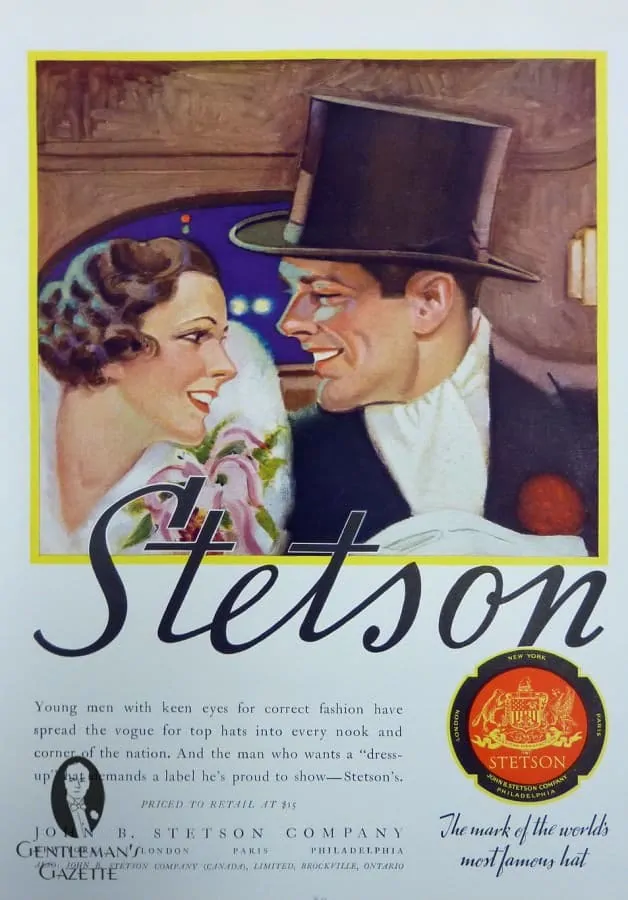
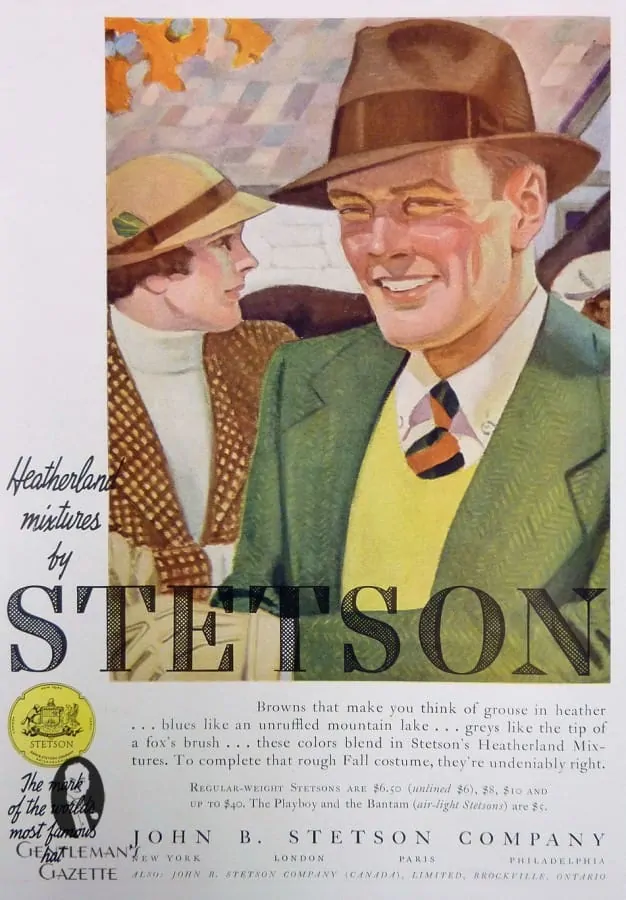
Unlike the other numerous small hat companies, big player Stetson is still around today. About 80 years ago, they already had built a great reputation and added a red sticker to their hats that stated “The mark of the world’s most famous hats”. Although they maintained stores in New York, London, Paris and Philadelphia most of the beaver fur used to make hats was sourced in Canada.
In 1935, when it was en vogue to wear white tie to glamorous parties, they also offered silk top hats that retailed for $15. The ad states:
” Young men with keen eyes for correct fashion have spread the vogue for top hats into every nook and corner of the nation. And the man who wants a “dress-up” that demands a label he’s proud of to show.”
Stetson’s
On the right, you can see an ad highlighting the Heatherland mixtures for fall. The colors are perfect for that time of the year. Although a top hat was a bit more difficult to make, the silk and shellac used were less expensive because the most expensive Stetsons cost up to $40, although a standard would only set you back $6.50.
“Browns that make you think of grouse in heather… blues like an unruffled mountain lake… grey like the tip of a fox’s brush … these colors blend in Stetson’s Heatherland Mixtures. To complete that rough Fall costume, they’re undeniably right. “
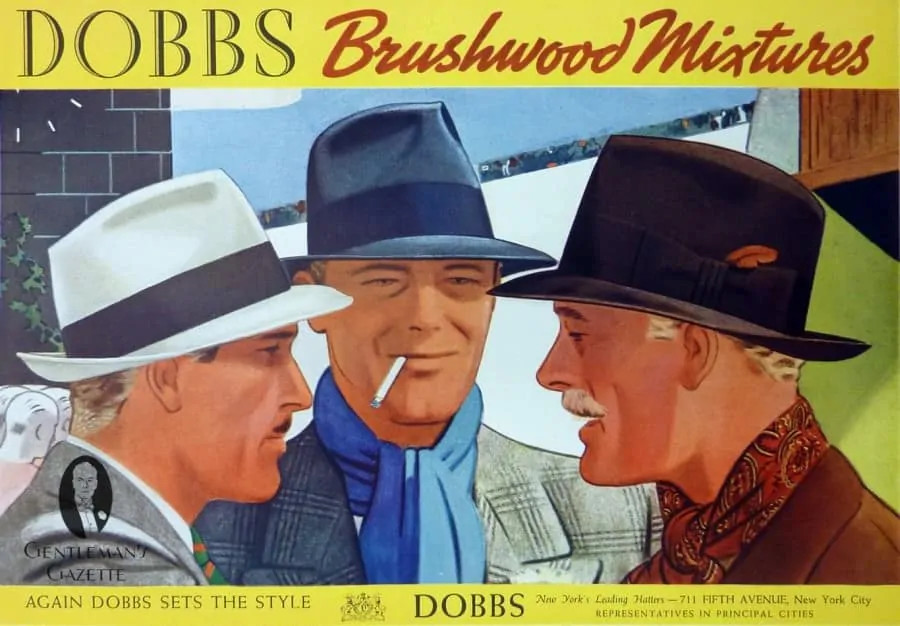
Another renowned hat label at the time was Dobbs, which claimed to be New York’s leading hatter. The hats were made by the Hat Corporation of America, which also made Knox, Dunlap, Cavanagh, Crofut & Knapp etc. and was known as a quality hatter. Today, you can still find new Dobbs hats, but they don’t have anything to do with the quality hats they used to be. Vintage enthusiasts are very much interested in Dobbs hats and they sell well on places like ebay. In this ad, the Brushwood mixtures were advertised for fall/winter. Personally, I like the Prince of Wales check suit with the blue scarf in the middle with a gray-blue hat; it works rather well. The gent on the right wears his red paisley scarf with a brown ensemble which also works rather well together. On the left, we see a gray and white ensemble and although winter white is difficult to keep clean, it looks very debonair if you have a good tan.
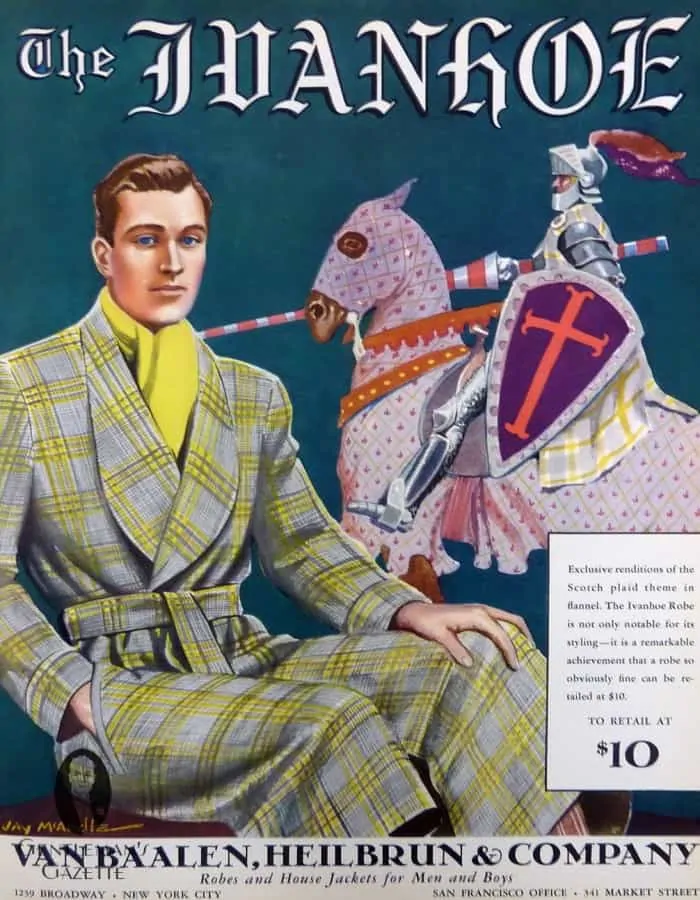
Robes & Dressing Gowns
Another popular wardrobe item for men back then was a robe or dressing gown, but they did not have anything to do with cotton terry cloth robes you find today. Instead, they were always lined in silk (or later viscose and other artificial fibers) and often had a faced lapel, unless they were made of wool flannel. Unfortunately, not many men wear them anymore and due to the lack of demand, it is difficult to find quality dressing gowns anymore. For more information about dressing gowns in general, click here.
Compared to today, the ads look rather funny. For example the Ivanhoe robe above shows a mounted knight because Van Baalen, Heilbrun and Company probably didn’t sound too interesting for potential buyers. The Drake robe ad below implied your wife will now feed you happily, and the regimental gowns will make you feel like an Englishman… Even though all of this was of course not true, a dressing gown is a magificent garment for the cold days at home.
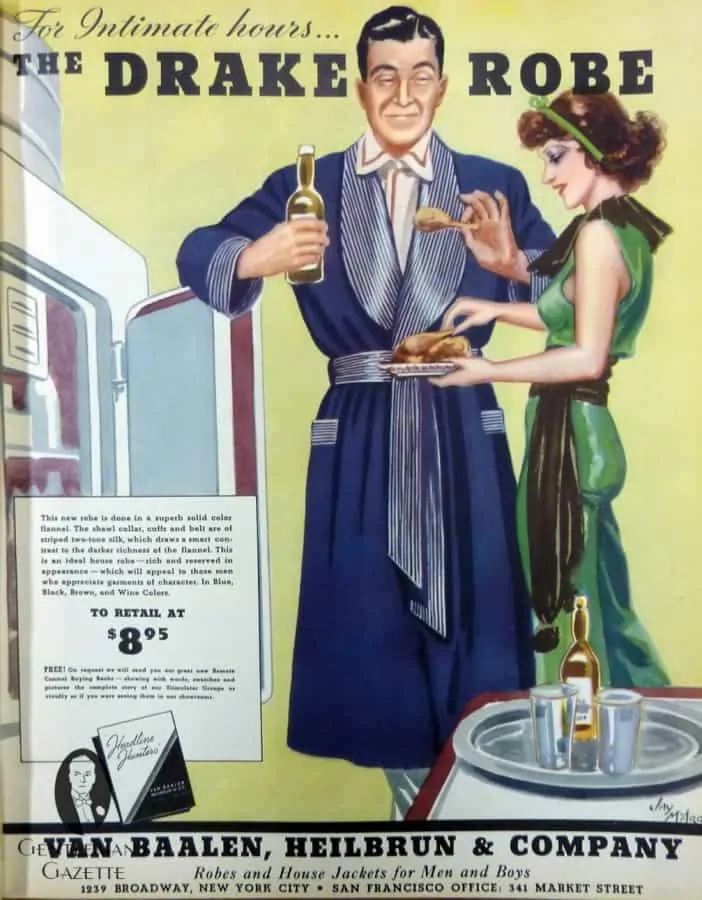
Accessories & Fabrics
Back then, it was not uncommon for lining or fabric specialists to advertise, and so you would see cloth ads next to ads for accessories. The look was often not different from other ads with the exception that they always highlighted the fabric. Here we can see Longchamp Satin, which has nothing to do with the Longchamp brand we know today, and Linings by William Skinner & Sons which is now defunct.
The ads claims that the argument about the king of sports will always remain open, while the question for the best linings has long been answered. That’s why you see men in white tie, golf club and fishing pole…
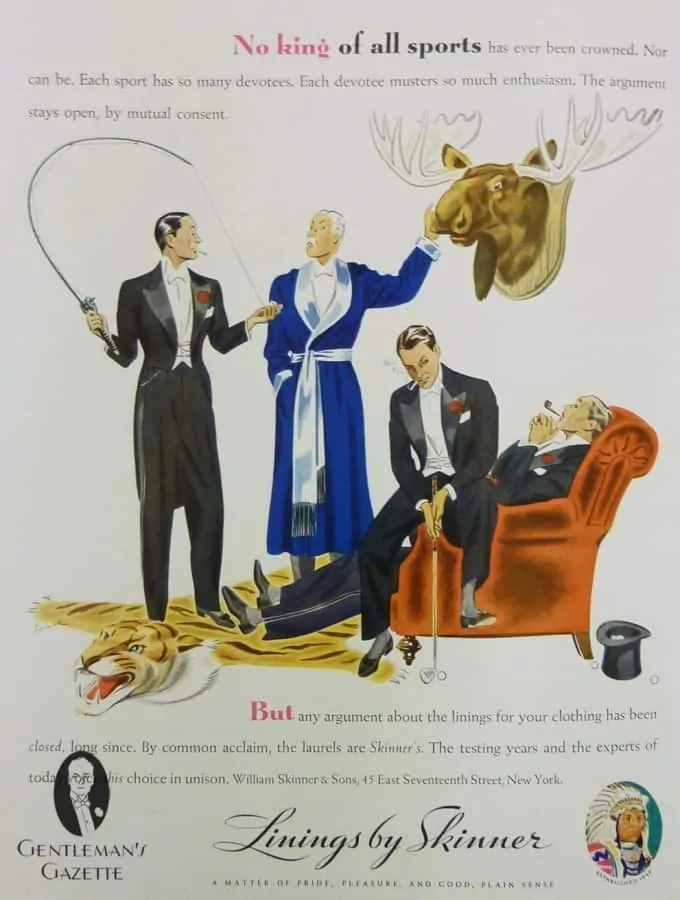
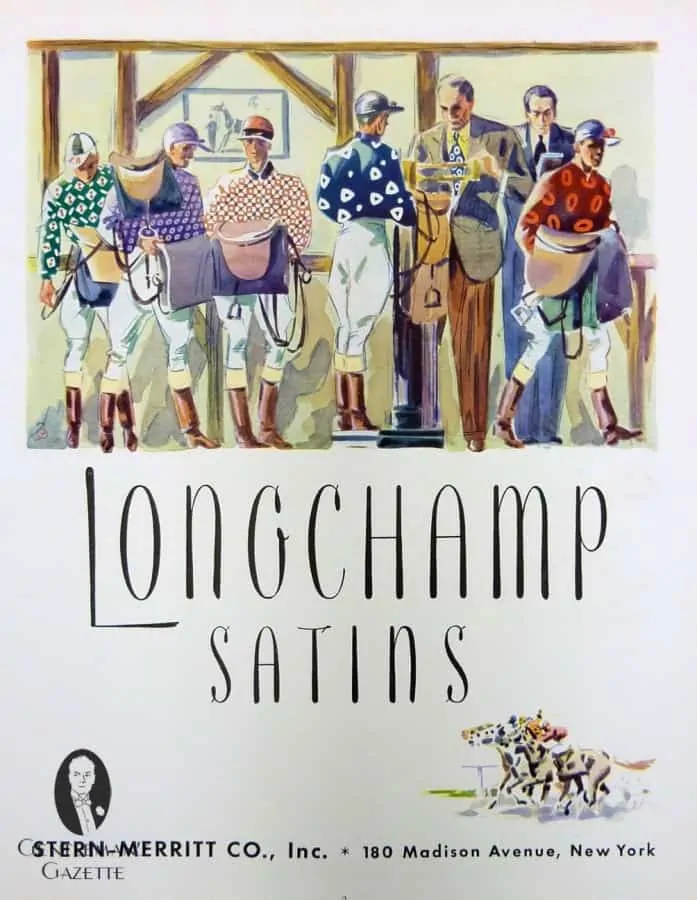
Accessories back then were colorful and featured classic patterns such as paisley of macclesfield neats (the small geometric printed patterns you can see on the pocket squares here). Also, note how accessories were distinguished by sport, formal and business. Most men today would not know the difference between formal and business and they would never wear a pocket square for sports. However, if you categorize your tie, scarf and pocket square collection in casual, business and formal patterns and colors, you will find it easier to dress appropriately because you always just combine the things that were meant to be worn with each other.
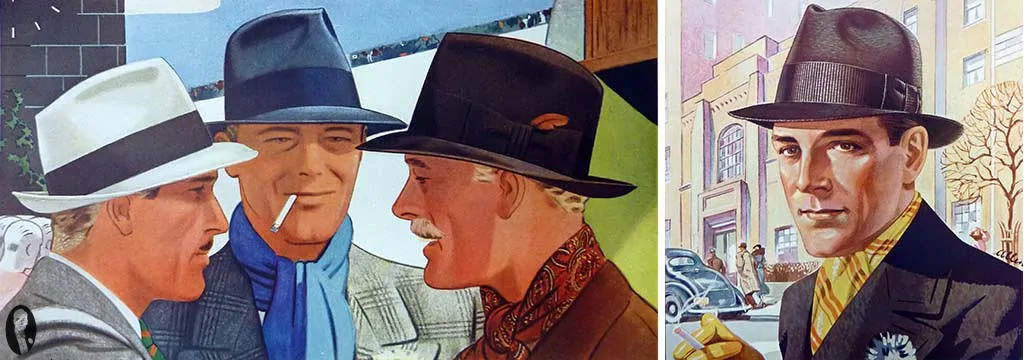
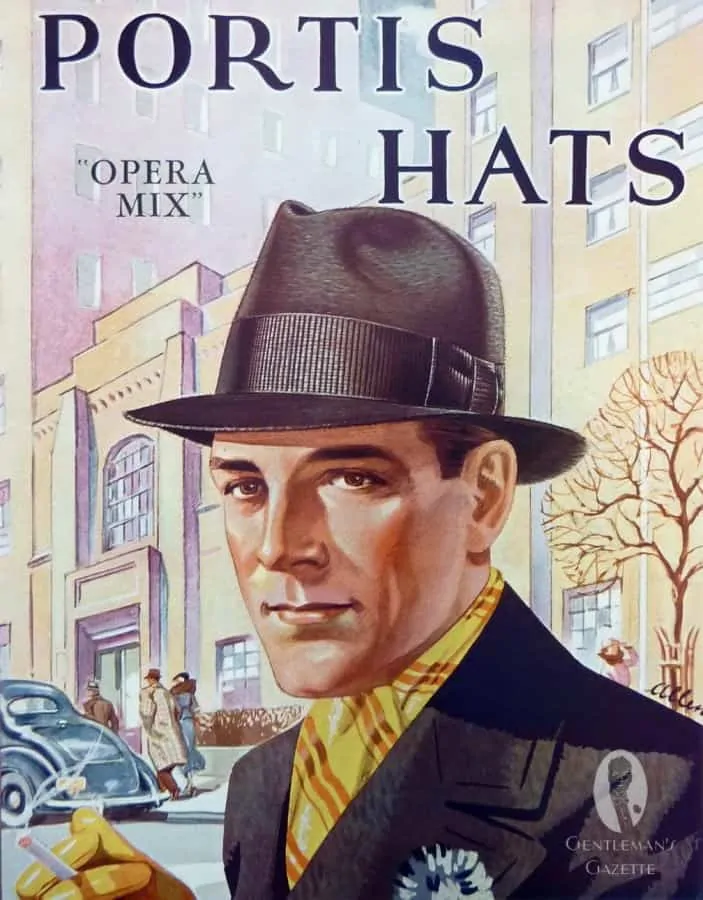
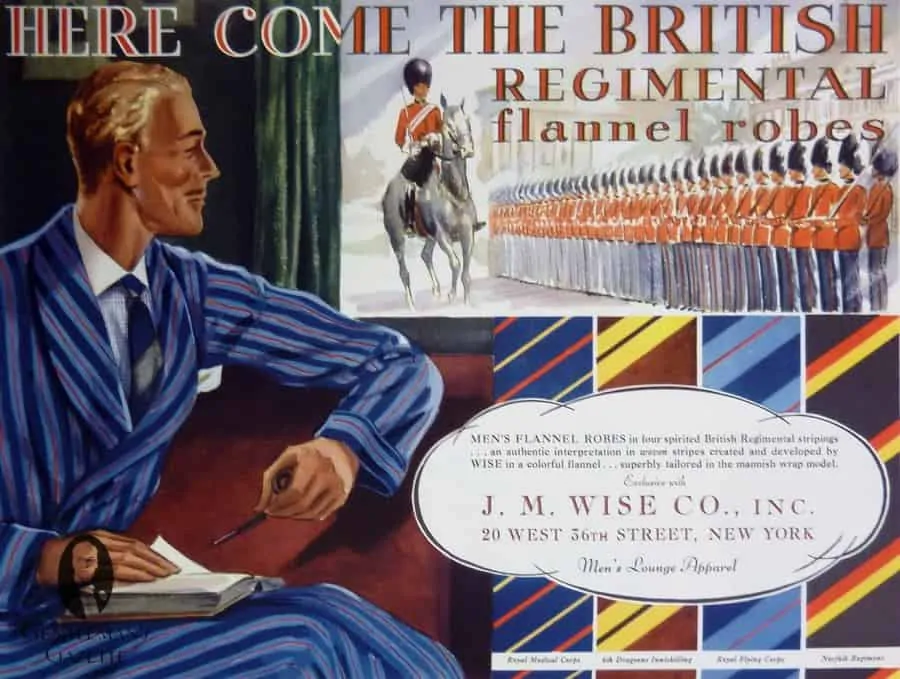
I am referring now to the 1950’s-60’s. When we were assigned to the detective bureau from the uniform division it was assumed you would have business like attire. That being, suits or sports coats, dress shirts,,ties and a fur felt hat. When subpoenaed to appear in court, uniformed or plainclothes officers were expected to be dressed appropriately, a suit and tie or a complete uniform.
Today, I see traffic and patrol officers in blue jeans, open collar, short sleeve uniform shirt and baseball caps. Detectives come to work in blue jeans and sweat shirts. What is happening to our society?
What has happened to “our” society, is that it has collectively ‘gone down the tubes!’ Plain & simple. … of biblical proportions!!!
Charming article.
Thank you!
I concur!! … most inspiring, natty!
There was a time when men were men and dressing sharp was a way of life. Now we all live in jeans and ‘T’ shirts unless a suit is an absolute necessity. I personally haven’t worn a suit or a tie in over five years…But am considering a change to that. Casual is fine but it’s getting old….I really don’t go any where where it’s necessary to be dressed like that but a change would be nice. I do like my hat’s though…
Stylishness is not necessarily a slavish following of past tradition, and we might ask what a gentleman of a half century ago would have carried, as a matter of routine, and what he might carry today. In the past, there would be a fountain pen, checkbook, and a billfold. One can see some need for a notebook, and a utilitarian handkerchief so as to leave the pocket square as decoration.
But what of today? Mobile telephones and tablet computers have entered the list of personal necessities. That may lead to some sort of charger device and lead. I have the impression that the plug and socket standard in the USA does not force such things to be bulky, but it still adds up to something more than a packet of cigarettes and a lighter.
If anything, all this paraphernalia makes the jacket a better answer than it might have been some twenty years ago, but it will hang a little differently, and what we have in our pockets has changed.
It might even be the time to revive even older answers. The modern belt-pouch can be traced back to the medieval purse, but that name has shifted in another direction. And, let us face it. while we may have joked about the remarkable capacity of a lady’s handbag, they do have the advantage on us today.
No, I cannot imagine emulating a movie hero, and resorting to a WW2 gas mask case. While it overlaps with such things as the messenger bag, it seems just too casual. But I do not think we can condemn the idea as ungentlemanly. Yet how could we get it right?
Interesting point. I have seen jackets designed for modern gadgets, and the poacher’s pocket is big enough for any kind of tablet nowadays. I don’t think men necessarily need a bag or purse of some kind though.
I have some waistcoats with five inch deep pockets which take a large smartphone. A flap or jetted opening would be nice to stop it sliding out when bending down. Jacket pockets are big enough, but sometimes you want to leave your jacket off indoors, and there is risk of theft.
My very clothes conscious father has been using a WWII Gas Mask Bag (and other old military & PO bags) since the 1960s when there were no messenger bags or other man-purses to be had for his weekend wear. They would match up with “Safari” style jackets he’d get from surplus stores and Banana Republic (back when they were just a high end military surplus store) with lots of pockets. He generally doesn’t haul big items to formal occasions where he wears a suit, or slacks and dressy sport coat and tie, but if he must, he generally goes with a nice leather messenger bag that matches his shoe leather color. When we travel and he wants to bring lots of gadgets with him he goes for Scott e-vest coats, vests, or jackets so he can strip all of his peripherals off when going through security. They have pockets big enough for an ipad yet they look pretty normal. I wear women’s ones when flying for this reason.
So much to gain from this piece. Thanks a lot Raphael for consitently being the beacon of fine taste
What a great article. I think the time is right for a re introduction of mens Dressing Gowns made in the old way with wonderful wool. Perhaps a slight drop in weight may be a good idea. Time for designing!
Dear Mr. Schneider,
thank you very much for sharing once again your collection of fashion ads with your readers. Before all the fall outfits shown on the Alexander ad have been very inspirational with respect to the combinations of colors.
@ Ed Staal
Although you are right with your observation that most mens’ outfits have indeed become far too casual, I wouldn’t say that all hope is lost. In fact, more and more young men show interest in classical style, and even if one might be in the minority, one can still set a good example. I’ve done so at my workplace, which has comparatively low standards with regards to the dress code, and it worked. People often just won’t do things because they’ve never seen others do so. It’s no other thing with dressing well.
A wonderful walk through the past which is clearly not black and white. It is filled with textures, colours and style. It is glorious to see. Thank you very much for sharing them.
Being a high school English teacher I’m horrified at the attire of some of my colleagues in this age of ‘dress down’ Fridays…which essentially means ‘every day’. Some look as if they are going to paint their house, chop wood, or exercise. There is plenty of appropriate attire for that. Students do respond differently to teachers who look like role models and not like adults trying to be teenagers again.
Thankfully, I have been able to influence many of my colleagues who occasionally chide me on my clothing. Most end up feeling embarrassed and we end up engaging in a discussion about modelling and self respect. Which luckily grows into queries about my shirt, tie, shoes and blazer.
I occasionally find myself responding to the question “What are you so dressed up for?” with “Why are you so poorly dressed for work?”. The issue I find is that it is not why I am dressed up for my job, it is that why are they not.
I’ve just turned 40 and have been wearing a shirt and tie since I started teaching 16 years ago.
Clothing and attitude do make a difference.
Once again, way back when, with our arbiter elegantiarum–Sven! Top job!
The golden era of men’s fashion seems to be from the 30s to the mid 50s. Then, the lapels narrowed and the pleats disappeared; much like today’s suits. The other commenters are correct-no one dresses for work or dining anymore. Web sites such as yours continue to remind us of the standards of appearance, decorum and affectations gentlemen should strive for. Thank you.
Why do you think the level of formality has dropped so much in our society? What do you think attributes to this change?
Thanks
It may, in my humble opinion, have a lot to do with the socio-cultural changes that took place in the late 60s. While in their course a lot of unjustified prejudices against minorities were questioned and more personal freedom for everyone appeared, formality on all levels of life became a collateral damage of this process, as being considered outdated and restrictive and, what’s more important, linked with the world that tolerated such grievances.
Then, there was the rise of the New Economy that brought up self made men who in spite of their most neglected dress were successful and in consequence became role models for others, before all in computer-related job fields that, with no doubt, abound.
On the other hand, I must repeat that the progress that has been going on eversince is not at all irreversible.The bare existence of a site such as this and the number of readers enjoying it should prove otherwise.
Muster your optimism, gentlemen !
“My hat is off to you”!
what a delightfully informative article I also gained insight from the many comments shared on the different perspectives on why such understandings as to how gentlemen today have a diverse view on what is fashionable.
I personally consider myself to be a whole lot of “old school” and greatly appreciate fashion styles of the past the quality, nuance and the well put-together-look of the everyday man from the past, his attire from head to toe reflected a sense of pride in his personal appearance this can be seen even in photos of crowds from the 40’s and 50’s attending something as simple as a baseball game!
Best Regards,
Park Jacob Weatherby
I love these kinds of articles, my job is a dirty one so dressing for work is not possible and finding a reason to dress in shirt, tie and coat is very far and few. I would love to be able to get decked out a few times a month just “because”. Thank you for such great stories.
A correction, if I may, Stetson is not still around today. The brand is, but the John B. Stetson Co. closed its doors for good in the 70’s. The Stetson name is licensed to whomever wishes to pay to use it. Hats bearing the Stetson name are a licensed product and not produced by the original Stetson company. Hatco makes Stetson hats and they also own the rights to pretty much every other former major manufacturer (Cavanagh, Dobbs, Knox, Mallory, and Resistol). The difference between a modern Dobbs and a modern Stetson is nil. They are both made in the same factory and its at the manufactures discretion which brand name they choose to attach to the hat. Stetson receives the most use as it is the most well known. Almost nothing they produce approaches the quality of the hats made by the original manufacturers regardless of what brand name they attach.
What a great informative article! It is really makes me infuriated when my friends and colleagues often ask me “Why are you so dressed up?” I simply reply by telling them that there is no such thing as over-dressing. Me only being 20 years old, I am quite ashamed with the way my generation carries themselves with the way they dress. I would rather be the best dressed man in the room than the under dressed man in the room any day of my life. Thanks again for a great read!
You are welcome Daniel! Keep dressing sharp.